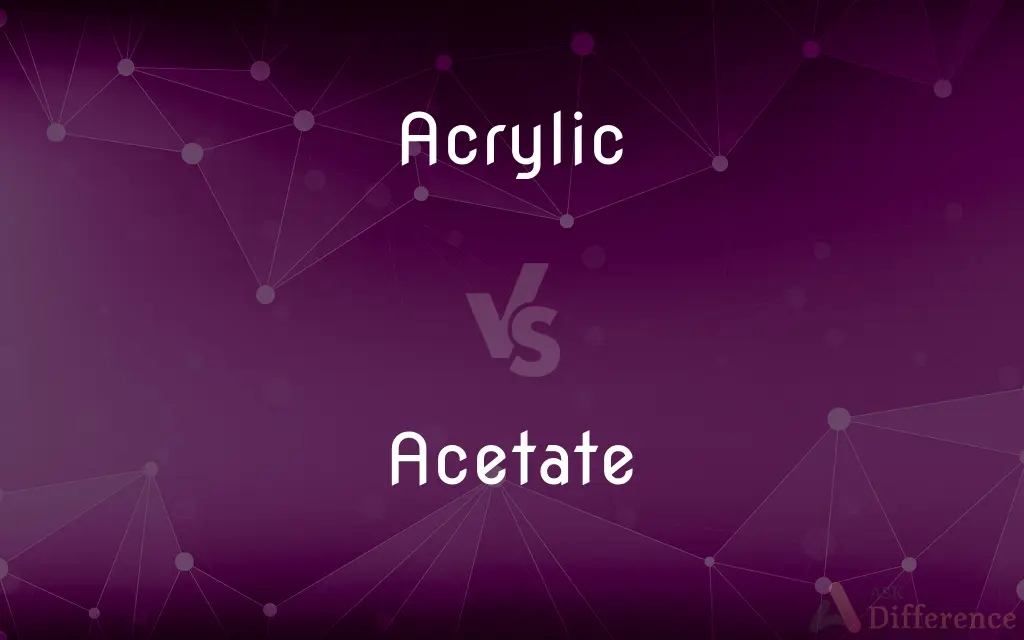Acrylic vs. Acetate — What's the Difference?
By Tayyaba Rehman — Updated on August 25, 2023
Acrylic is a synthetic polymer used in a wide range of products like paint and plastic, while acetate is a salt or ester of acetic acid used in items like film and textiles.

Difference Between Acrylic and Acetate
Table of Contents
ADVERTISEMENT
Key Differences
Acrylic is primarily a synthetic material made from polymerizing acrylic acid derivatives. It is widely known for its use in acrylic paints, which offer vibrant color and longevity. Acetate, on the other hand, is derived from acetic acid and is often used in the production of photographic films and textiles.
Acrylic fibers are used in textiles due to their lightweight nature and resistance to wear and tear. They're commonly used in garments and home furnishings. Acetate fibers are also used in textiles but are especially known for their luxurious feel, high drapability, and luster.
In terms of durability, acrylic is generally stronger and more resistant to external factors like weather and UV radiation. It's commonly used in outdoor applications. Acetate is sensitive to heat and solvents and is more often used indoors or for less demanding applications.
When it comes to environmental impact, acrylic production tends to require more energy and releases more toxic fumes than the manufacture of acetate. However, both materials pose challenges in terms of biodegradability and recycling.
Acrylic is frequently used in applications requiring transparency, like aquariums and display cases, due to its optical clarity. Acetate, though not as clear as acrylic, is often used in applications like eyewear and packaging where some level of transparency is desirable.
ADVERTISEMENT
Comparison Chart
Basic Definition
A synthetic polymer
A salt or ester of acetic acid
Common Uses
Paints, plastics, textiles
Films, textiles
Durability
Highly durable and weather-resistant
Less durable, sensitive to heat and solvents
Environmental Impact
More energy-intensive, toxic fumes
Less energy-intensive, still not biodegradable
Optical Properties
High clarity
Moderate clarity
Compare with Definitions
Acrylic
A type of paint with a fast-drying, water-based medium.
She used acrylic paint for her canvas art.
Acetate
An organic salt formed by reaction with acetic acid.
The scientist used an acetate in the chemical reaction.
Acrylic
A synthetic polymer used in high-grade plastics.
The acrylic display case showcased valuable artifacts.
Acetate
A type of synthetic fiber made from cellulose acetate.
The acetate fabric drapes beautifully.
Acrylic
A fiber made from acrylonitrile used in textiles.
The sweater was made from soft acrylic fibers.
Acetate
Cellulose acetate.
Acrylic
A transparent thermoplastic with optical clarity.
Acrylic glass was used for the aquarium.
Acetate
A transparent sheet used for overlays.
Acrylic
A medium for modeling and sculptures.
The artist used an acrylic medium to create the 3D effect.
Acetate
Ellipsis of acetate disc: a disc of aluminium covered in a wax used to make demonstration copies of a phonograph record.
Acrylic
A thick sheet of plastic.
Acetate
A chemical used in food as a preservative.
Acetate is often listed as an ingredient in preserved foods.
Acrylic
A liquid coating system based on an acrylic resin.
Acetate
An acetate is a salt formed by the combination of acetic acid with a base (e.g. alkaline, earthy, metallic, nonmetallic or radical base).
Acrylic
Of or containing acryl, the hypothetical radical of which acrolein is the hydride; as, acrylic acid. The characteristic residue in an acrylic compound is the carbonyl group attached directly to an ethylenic carbon.
Acetate
A salt or ester of acetic acid, containing the anion CH₃COO⁻ or the group —OOCCH₃.
Acrylic
An acrylic resin.
Acetate
A salt formed by the union of acetic acid with a base or positive radical; as, acetate of lead, acetate of potash.
Acrylic
A painting executed using such a paint.
Acetate
A plastic film used in photography and transparencies.
The old projector used acetate films.
Acrylic
Same as acrylic resin.
Acetate
Cellulose acetate or any of various products, especially fibers, derived from it.
Acrylic
Polymerized from acrylonitrile
Acetate
(organic chemistry) Any salt or ester of acetic acid.
Acrylic
A glassy thermoplastic; can be cast and molded or used in coatings and adhesives
Acetate
A component in coatings and inks.
The print shop used acetate-based ink for high-quality prints.
Acrylic
A synthetic fabric
Acetate
Cellulose acetate, especially as used to make textile fibres or plastic
Acetate silk
Acrylic
(of synthetic resins and textile fibres) made from polymers of acrylic acid or acrylates
A red acrylic jumper
Acetate
A salt or ester of acetic acid.
Acrylic
An acrylic textile fibre
A sweater in four-ply acrylic
Acetate
A salt or ester of acetic acid
Acrylic
An acrylic paint
Washes of white acrylic
She paints mainly in acrylics
Acetate
A fabric made from cellulose acetate fibers
Acrylic
A paint containing acrylic resin.
Acrylic
A painting done in acrylic resin.
Acrylic
Any of numerous synthetic fibers polymerized from acrylonitrile.
Acrylic
(organic chemistry) Derived from acrylic acid or acrylonitrile.
Acrylic
Containing an acrylic resin.
Acrylic
(organic chemistry) An acrylic resin.
Acrylic
(painting) A paint containing an acrylic resin.
When it comes to painting, I prefer using acrylics as my medium.
Acrylic
Same as acrylic fiber.
Acrylic
A paint in which the pigment is suspended in a solution of an acrylic resin, which dries to a hard film on exposure to air.
Acrylic
A painting made using an acrylic paint.
Acrylic
Used especially by artists
Common Curiosities
Is acrylic natural or synthetic?
Acrylic is a synthetic material made from polymerizing acrylic acid derivatives.
What is acetate commonly used for?
Acetate is often used in the production of films, textiles, and as a chemical reagent.
Can I use acrylic for outdoor applications?
Yes, due to its durability and weather resistance, acrylic is suitable for outdoor use.
Is acetate transparent?
Acetate can offer moderate levels of transparency, although it's not as clear as acrylic.
How durable is acrylic?
Acrylic is highly durable, weather-resistant, and can stand up to UV radiation.
Can acetate be used in clothing?
Yes, acetate fibers are known for their luxurious feel and are used in textiles.
What's the difference between acrylic paint and other paints?
Acrylic paint is fast-drying and water-based, offering vibrant color and longevity.
Is acetate environmentally friendly?
While less energy-intensive than acrylic, acetate still poses challenges in terms of biodegradability.
Is acrylic resistant to solvents?
Acrylic can be damaged by strong solvents like acetone but is generally chemically stable.
What are the safety concerns related to acetate?
Acetate is generally considered safe for use in many applications but can be flammable and should be handled with care.
Share Your Discovery

Previous Comparison
Despondent vs. Respondent
Next Comparison
Nutritious vs. NourishingAuthor Spotlight
Written by
Tayyaba RehmanTayyaba Rehman is a distinguished writer, currently serving as a primary contributor to askdifference.com. As a researcher in semantics and etymology, Tayyaba's passion for the complexity of languages and their distinctions has found a perfect home on the platform. Tayyaba delves into the intricacies of language, distinguishing between commonly confused words and phrases, thereby providing clarity for readers worldwide.















































